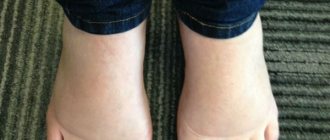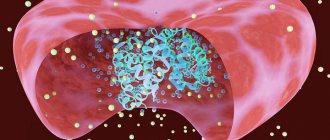We often receive the following requests: “eyelids are swollen - what to do?” We answer: swelling of the eyelids occurs due to excess accumulation of fluid. Any person is susceptible to this disease - children, adults, and the elderly. Both the upper and lower eyelids, or both eyelids at once, can swell. The problem may affect only one or both eyes at a time.
Find your nearest optical store
The cause of swelling of the eyelids can be eye disease, diseases not related to the visual system, lifestyle and a one-time reaction of the body to any factors.
Together with ophthalmologists from the “Happy Look” optical salon chain, we will figure out why the eyelids swell, how to treat it, and whether you need to see a doctor about this problem.
General information
Edema is the accumulation of fluid in the extracellular space.
Edema is considered local if fluid accumulates in a limited part of the body. If this concerns the eyelids, then fluid accumulation occurs in the loose subcutaneous fatty tissue of the paraorbital region. Swelling in this area forms very easily. This is due to the fact that the layer of subcutaneous tissue is loose, the muscles are poorly developed, and the blood supply is very good. Swelling of the eyelids is a common phenomenon that causes anxiety and aesthetic discomfort. Swelling of the upper eyelid is more common. Severe swelling of the lower eyelids is called “bags under the eyes.”
Swelling is a symptom of diseases (local or general), as well as a consequence of an unhealthy lifestyle - in this case we are talking about physiological edema that occurs periodically when diet or water regime is violated, or when drinking alcohol, and goes away on its own when these causes are eliminated. Thus, swelling of the upper eyelid in the morning after sleep and gradually disappearing over a few hours is often associated with precisely these reasons. Age plays a big role in the appearance of eyelid swelling. In older people, the appearance of "bags" is not always associated with swelling - they can be fatty hernias that do not decrease during the day.
Swelling associated with ophthalmological or general diseases does not go away on its own - it is important to establish a diagnosis and treat the underlying disease. Persistent swelling should not be considered a cosmetic problem - you should consult a doctor.
Treatment with folk remedies
It often happens that treatment for blepharitis is delayed for many months. It is highly undesirable to use medications during this period. In such situations, traditional medicine becomes a good alternative. Infusions and decoctions of medicinal herbs are usually used, for example:
- sage;
- chamomile;
- calendula;
- Kalanchoe;
- eucalyptus.
A well-proven remedy is onion decoction with the addition of boric acid. It is recommended to wash your eyes with it no more than twice a day. Propolis is considered an effective remedy. A teaspoon of crushed substance is mixed with 100 grams of Vaseline. After this, place it in an opaque container. The damaged area of the eyelid should be carefully lubricated with a thin layer of the resulting solution.
Traditional medicine is “rich” in a variety of recipes for the treatment of ophthalmological diseases. You can use various plants. It can be aloe, and drupe, and parsley. The main thing is to follow the recipe and consult with your doctor before starting to use such products.
Pathogenesis
In the pathogenesis of any edema, the following are important:
- increased permeability of the vascular wall;
- high intravascular pressure;
- a decrease in the level of proteins in the blood that hold the liquid part of the blood inside the vessel;
- increased concentration of salts in tissues;
- disruption of the outflow of venous blood and lymph.
The development of swelling of the eyelids is facilitated by the increased extensibility of the skin in this area, good blood supply, loose fatty tissue that can accumulate fluid and poor development of the muscles that provide elasticity to the eyelids. If we consider allergic edema, then all allergy symptoms, including swelling, are associated with the release of mediators from mast cells and basophils. The main mediator of the immediate response is histamine . Through H1 and H2 receptors, this mediator causes vasodilation, increased vascular permeability and the formation of prostaglandins (inflammatory mediators). These mechanisms explain the development of allergic tissue edema .
How to avoid relapse of the disease
Diseases of the visual organs, whether conjunctivitis, stye, blepharitis or allergies, are directly related to the state of the human immune system. When the immune system is weakened due to frequent colds, inflammation of various types, and infections, the body loses its natural defenses and becomes vulnerable to viruses, bacteria and parasites, which provoke inflammation and swelling of the eyelids.
What should you do to avoid relapse? If the upper eyelid of one or both eyes is constantly swollen, you should undergo a full ophthalmological examination and, if everything is normal, simply reconsider your lifestyle, paying attention to hardening, proper nutrition and sports. As soon as your body gets stronger, relapses of unpleasant diseases will stop.
Classification
Depending on the cause, swelling of the paraorbital area can be:
- Inflammatory.
- Non-inflammatory.
- Allergic.
- Traumatic.
By localization:
- Unilateral.
- Double-sided.
- Upper eyelid.
- Lower eyelid.
- Damage to the inner edge of the eyelid.
- Damage to the outer edge.
Traumatic . This type is typical for any injury to the eyelid - bruise , surgery during plastic surgery, tattooing, as well as microtrauma to the inner surface of the eyelids when wearing contact lenses.
Inflammatory swelling is associated with any infectious eye diseases of a viral, bacterial, chlamydial nature, as well as inflammation of the paranasal sinuses. Infectious and inflammatory diseases are the most common reason for visiting an ophthalmologist. In the structure of these diseases, the main place is occupied by conjunctivitis and blepharitis , which in severe cases cause severe swelling of the eyelids. The main symptom is redness, increased local temperature, eyelid tension and severe pain. This is most often a one-way process.
Non-inflammatory edema is associated with diseases of internal organs (liver, kidneys, thyroid gland), alcohol abuse, and consumption of salty and spicy foods. This type also develops when the head is positioned incorrectly during sleep.
In this case, fluid accumulates in the eyelid area and in the morning the person experiences bilateral swelling. Non-inflammatory swelling can also be allergic in nature.
Allergic swelling of the eyelids develops upon contact with allergens, which may include:
- cosmetical tools;
- household chemicals;
- plant pollen;
- animal hair;
- insect poison proteins;
- food products;
- medications;
- house dust;
- industrial pollution;
- contact lenses;
- household chemicals;
- exposure to cold ( cold allergy ).
Allergic edema develops immediately, and the symptoms progress - the eye rapidly swells and turns red, and attacks of suffocation are possible. Quincke's edema is known , in which not only the eyelid swells, but also the tissues of the head, neck, and larynx, which is accompanied by difficulty breathing and requires emergency care. Allergic conjunctivitis can be an independent disease, but more often it accompanies seasonal and year-round rhinitis , urticaria , dermatitis , and drug allergies . The prolonged course of conjunctivitis reduces the quality of life of patients.
Dense swelling of the face and eyelids is characteristic of myxedema , a condition associated with insufficient thyroid function - a severe degree of hypothyroidism .
What is blepharitis?
In this article
- What is blepharitis?
- Signs of the upper eyelid
- Why does blepharitis of the upper eyelid develop?
- Diagnosis of the disease
- What is the difficulty in diagnosing blepharitis of the upper eyelid?
- What types of blepharitis affect the upper eyelid?
- What is local therapy?
- Methods of etiological treatment
- Principles of restorative therapy
- Hygiene procedures for blepharitis of the upper eyelid
- Treatment with folk remedies
- Blepharitis of the upper eyelid. Treatment prognosis
Blepharitis is the Latin name for a very wide group of ophthalmological diseases. They have different symptoms, inflammations can form in different places. In most cases, blepharitis affects the edges of the eyelid. This can happen both from the outside and from the inside. Often the inflammatory process affects the meibomian glands. There are quite a few types of disease. They all differ in different pathogens, but are accompanied by largely similar symptoms.
The difficulty with blepharitis is that this disease is difficult to treat. The localization of the inflammatory process almost always develops in the ciliary edges of the eyelids. The disease has a tendency to relapse. It can last for a very long time and, as a result, become chronic. Blepharitis is quite difficult for the patient to tolerate. The disease leads to decreased performance and can often lead to decreased and even loss of vision. If discomfort occurs, it is necessary to find out the source of the discomfort and seek help from an ophthalmologist.
Causes of eyelid swelling
Swelling of the eyelids can be pathological and non-pathological. Non-pathological causes include:
- Eye fatigue (any prolonged eye strain, being in front of a computer) and insufficient sleep.
- Poor nutrition - abuse of salty foods and salt, which retains water in the body. Eating spicy foods is accompanied by thirst and intake of large amounts of liquid.
- Excessive drinking.
- Alcohol abuse is the cause of swelling in the morning.
- Incorrect head position during sleep. When sleeping on a very low pillow or without a pillow, there is greater blood flow to the head and bilateral edema develops. Lying on one side causes a predominant accumulation of fluid on this side and unilateral swelling.
- Poor quality makeup, lack of habit of removing it from the face and eyes.
- Cosmetology procedures - eyelash extensions, tattooing of eyelids, eyebrows, “rejuvenating” injections.
- Injury. When the bridge of the nose is bruised, the area of both eyes swells; unilateral swelling is observed when one eye is injured. Various maxillofacial and facial plastic surgeries are always accompanied by swelling.
- Genetic predisposition. People with thin and sensitive skin experience swelling of the eyelids every day in the morning after drinking an extra glass of water or intense physical activity.
- Age. With age, the periorbital tissues and muscles weaken. Fiber fat sinks and accumulates more fluid, forming “bags” under the eyes.
If we consider pathological swelling of the eyelids, then their causes may be eye diseases and general diseases. The following diseases, to varying degrees, cause swelling of the lower or upper eyelid:
- Barley . Before a lump forms at the edge of the eyelid, there is swelling and tenderness. The swelling intensifies over several days, the eyelid turns red, but the site of inflammation of the sebaceous gland is localized and a limited compaction forms, in the center of which pus appears over time. After opening the formation, the swelling gradually decreases.
- Conjunctivitis . The most common causes are streptococci and staphylococci. These diseases are also caused by viruses, chlamydia and fungi. In severe cases, swelling of the eyelids develops. Most often, infectious-allergic conjunctivitis occurs in children.
- Blepharoconjunctivitis is an inflammation of the mucous membrane of the eye and the edge of the eyelids.
- Trachoma . The disease is caused by chlamydia.
- Endophthalmitis.
- Chalazion . Inflammation of the eyelid margin, involving the meibomian gland and eyelid cartilage. Often chronic.
- Blepharitis . Inflammation of the ciliary edge of the eyelid, accompanied by redness, itching, swelling and peeling of the eyelids, and loss of eyelashes. Blepharitis is of an allergic nature and develops with demodicosis and metabolic disorders.
- Ocular herpes (ophthalmoherpes). Manifested by swelling around the eye, pain, itching, redness of the conjunctiva.
- Oncological process and benign neoplasms of the century.
- Tuberculosis of the eye.
- Graves' disease . Associated with increased production of thyroid hormones. In addition to exophthalmos (protrusion and displacement of the eyeball), swelling of the periorbital tissue is noted.
- Hypothyroidism and myxedema .
- Fatty hernia and sinusitis are accompanied by swelling of the lower eyelid.
- ENT diseases. Inflammation of the maxillary sinuses is accompanied by swelling of the lower eyelid. Ethmoiditis occurs with swelling of the inner corners of the upper and lower eyelids.
- Kidney diseases. Swelling on the eyelids is bilateral, pale, soft to the touch.
- Diseases of the cardiovascular system.
- Hormonal changes. For example, on certain days of the menstrual cycle (before menstruation), swelling of the eyelids appears. Hormonal changes during pregnancy also contribute to the accumulation of fluid in the body.
Causes of swelling of the upper eyelid:
- Blepharoconjunctivitis.
- Frontitis (inflammation of the frontal sinus).
- Barley (typically affecting one eye).
- Cellulitis of the century.
If the upper eyelid is swollen in one eye, the reasons may be:
- Eyelid trauma is a mechanical impact on any eye. This can include blows, as well as eyelash extensions and tattooing of eyelids and eyebrows, which also refers to trauma and very often causes swelling. After tattooing, swelling goes away within 2 days. Longer persistence of swelling indicates poor quality of the pigment or its very deep introduction, as well as the development of an allergic reaction due to the wrong choice of anesthetic. Short-term swelling develops after anti-aging procedures (contour plastic surgery, eyelid lifting).
- Impaired outflow of blood and lymph (with orbital tumors that compress the veins, swelling of the eyelid develops in one eye).
- Insect bites (unilateral allergic swelling occurs).
- Staying in a draft, driving in a car with the windows open.
- Sleeping in an uncomfortable position for a long time on one side.
Methods of etiological treatment
The principles of etiological treatment are aimed at eliminating the underlying cause of the disease. This allows you to avoid relapse of the disease in the future and its transition to the chronic stage. The most common causative agent of upper eyelid blepharitis is Staphylococcus aureus. In this case, ophthalmologists prescribe antibiotics, which allows you to “pacify” the action of pathogenic microorganisms.
The cause of blepharitis of the upper eyelid is often helminthization of the body - infection of the body with helminths. In such cases, for effective treatment, it is recommended to take antihelminthic drugs. This procedure is necessarily carried out with the subsequent neutralization of the released parasites, their fragments, larvae and eggs.
If the causative agent of the disease is fungi, then antifungal drugs - antimycotics - are prescribed. Among the drugs of this class, polyenes are considered universal. When used topically, they act on spores of fungi, unicellular organisms, and parasites. Drugs in this group have shown themselves to be effective in treating external mucous membranes and preventing relapses.
If blepharitis of the upper eyelid has been diagnosed, then increased attention is paid to its treatment. Allergic reactions often occur in women who constantly use decorative cosmetics. The components contained inside it often cause an allergic reaction. In such cases, treatment is often supplemented by consultations with an allergist and dermatologist.
Symptoms
Common symptoms of edema of the upper eyelid are swelling, which makes it difficult to fully open the eye, an increase in the size of the eyelid, tension and thickening, and narrowing of the palpebral fissure. Other symptoms depend on the disease that caused the swelling.
With physiological swelling that occurs in the morning, the swelling is bilateral and symmetrical. When sleeping on one side, swelling is greater on that side. There is no redness or soreness of the eyelids. After waking up, the swelling subsides within 1-2 hours.
With inflammatory edema, there is always redness of the skin, soreness, and an increase in local temperature. When you feel the edematous eyelid with barley or a boil , a subcutaneous compaction is detected. With conjunctivitis, there is pronounced redness of the conjunctiva, copious purulent discharge, discomfort in the eye, and irritation of the skin above the eyes.
Chlamydial conjunctivitis and blepharoconjunctivitis account for 20-30% of all conjunctivitis. Chlamydial conjunctivitis is more common in the summer when swimming in ponds and pools. First one eye turns red, and after 4 days the second is affected. Also noted are mucous discharge, lacrimation, itching and swelling of the eyelids, and photophobia.
In demodectic blepharitis, mites of the genus Demodex live and reproduce in the ducts of the meibomian glands and hair follicles of the eyelashes. Feeding on dead epithelial cells and gland secretions, it parasitizes in these places for many years without causing clinical manifestations. When certain factors occur, the mite becomes more active, causing the development of demodectic blepharitis. There is a burning sensation and itching that increases with heat. The eyelashes stick together, and white particles of the epidermis are found at their base (a type of frosted eyelashes). The edges of the eyelids thicken, turn red, and swelling of the eyelids and ciliary margin develops. With a prolonged course, conjunctivitis occurs.
When an insect bites (insect allergy), in addition to pronounced swelling, the site of the bite is detected. In people who are not sensitized to the insect allergen, only a local reaction occurs: redness, swelling, burning, itching, pain. Those who are sensitized may develop a rapid systemic reaction and even anaphylactic shock . In patients with increased sensitivity to bites, a pronounced local reaction is observed (painful swelling, sharp redness), and there may also be an inadequate reaction - a giant infiltration at the site of the bite. Often the bite site becomes infected.
Swelling of the eyelids during an allergic reaction is most often associated with angioedema , which develops suddenly. This swelling is very common and is most often localized on the upper eyelid, affecting the lower eyelid as well. Patients experience difficulty breathing and wheezing.
hematomas appear with swelling and discoloration of the skin. In case of a fracture of the base of the skull, the symptom of glasses due to hemorrhage in the periorbital tissue is characteristic.
If one eye is injured, due to loose tissue, swelling and hematoma also form on the other side. The swelling of the eyelids is so pronounced that it is difficult to open the eyelids even with an eyelid lifter.
Non-inflammatory swelling associated with general diseases is painless. They are always bilateral and more pronounced in the morning. With cardiovascular pathology, patients are worried about shortness of breath , pain in the heart, and swelling of the legs.
Drug therapy
You should immediately pay attention to the fact that all pharmacological drugs are prescribed by the attending physician only after an examination and taking into account the individual tolerance of the drug components.
Self-medication in cases of blepharitis brings only temporary relief, the disease does not go away and in the future it only complicates recovery. It is necessary to understand for what purpose and what result needs to be achieved using this or that drug.
When treating staphylococcal blepharitis, an important aspect is the choice of antibacterial drug. Broad-spectrum antibiotics (tetracyclines, fluoroquinolones) are most often used. Preference is given to ointment forms, as they allow simultaneously moisturizing and healing the wound surfaces of the eyelid margins.
Non-steroidal anti-inflammatory drugs are used to reduce the inflammatory response. They suppress the inflammatory response in tissues, reducing redness.
In case of severe burning, itching, swelling of tissues, it is recommended to take orally and locally use (instillation) antiallergic drugs. These drugs reduce discomfort from the clinical manifestations of inflammation, thereby alleviating the patient’s condition.
Next, tear replacement therapy is used - its goal is to replenish the tear deficiency, protect the ocular surface from the effects of negative factors, moisturize and reduce the symptoms of a foreign body in the eye. To do this, use drops with gel textures containing hyaluronic acid.
During treatment, you should limit visiting the pool, sauna and baths, and taking warm baths.
In case of a prolonged inflammatory process, you may need to consult a gastroenterologist, dermatologist (for the prevalence of seborrhea, atopic dermatitis, rosacea on the surface of the skin in the face), a nutritionist (for nutrition correction - exclusion from the diet of spicy, salty, acidic foods, as well as foods with high sugar and gluten content).
If a patient is diagnosed with blepharitis, you need to understand that the duration of treatment and the speed of getting rid of this disease directly depends on following the specialist’s instructions. Usually, when the process is chronic and a late visit to the doctor, improvement occurs very slowly, and the risk of exacerbation of the disease is high. The most difficult treatment is for staphylococcal blepharitis, which can lead to the appearance of styes, chalazions, inflammation of the conjunctiva and cornea of the eye.
When conducting scientific research and clinical trials, experts came to the conclusion that a universal approach to treatment is ineffective. A combination of treatment strategies was most effective in chronic blepharitis, and these methods required an individual approach to each patient. Drug treatment in combination with hygiene and eyelid massage is the most modern model in the treatment of this pathology.
Tests and diagnostics
Examination of a patient by an ophthalmologist. This is usually enough to identify the disease and make a diagnosis. If necessary, additional examinations are prescribed:
- Culture of eye discharge.
- demodicosis is suspected .
- Ultrasound.
- Biochemical tests to assess kidney and liver function.
- Determination of the level of specific IgE in allergic diseases.
- Tests with allergens (nasal/conjunctival) in case the results of determining allergen-specific IgE are questionable.
Diet
Diet 15 table
- Efficacy: therapeutic effect after 2 weeks
- Timing: constantly
- Cost of food: 1600-1800 rubles per week
For swelling of the face and eyelids, it is recommended to limit the consumption of salt and spicy fatty foods. At the same time, an increase in vegetables and fruits in the diet has a diuretic effect. Plums, apricots, peaches, watermelons, cranberries, and rosehip decoction have this effect. You can supplement your diet with herbal teas. Drinking a lot of water is beneficial, provided that the person leads an active lifestyle and moves a lot. At the same time, the kidneys cope well with their function and fluid is not retained.
If you have a tendency to edema and abuse salty foods, drinking large amounts of liquid has the opposite effect - the liquid is retained in the body. It has been noticed that in hot weather, fluid is retained more, causing swelling not only of the face, but also of the feet and fingers.
Prevention
- Proper nutrition.
- Rejection of bad habits.
- Normalization of sleep.
- Active movements in the fresh air, walking - this prevents stagnation in any tissues. Dosage work at the computer and performing exercises to relax the eyes.
- Refusal to eat salty foods and large amounts of liquid.
- Timely contact an ophthalmologist if there are signs of eye pathology.
- Maintain hygiene when wearing contact lenses (rinse the lenses thoroughly, disinfect and promptly change the solution), remove lenses at night.
- Remove decorative cosmetics from your face.
- If you are prone to allergies, use new eye cream and new cosmetics with caution. To do this, it is worth trying new cosmetics on a limited area and observing the reaction.
- Periodically remove excess fluid from the body (visiting a sauna, taking diuretics, fasting for 24 hours).
- Treat diseases of the kidneys, cardiovascular and endocrine systems.
List of sources
- Kucherova A.A., Osidach N.V., Pobedennaya G.P. On the issue of differential diagnosis of conjunctivitis / Clinical immunology. Allergology. Infectology. 2015.— No. 1 (80), p. 49-51.
- Zaikov S.V. Allergic conjunctivitis: clinical picture, diagnosis, treatment/ Clinical immunology. Allergology. Infectology. – 2011. – No. 1. – P. 38–43.
- Avetisov S. E. Ophthalmology. National leadership. Brief edition 2021, 736 pp.
- Sidorenko E. I., Dubovskaya L. A. Eye diseases 2010.










